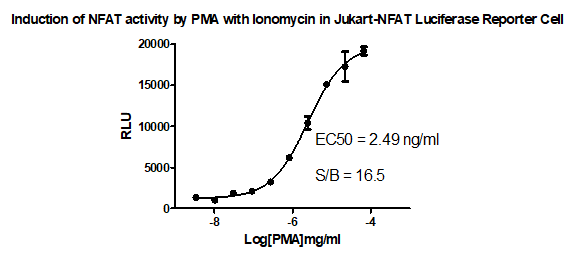

| RQP74025 | |
| I. Background | |
| The nuclear factor of activator T cells (NFAT) family of transcription factors plays an important role in immune response. T cell activation through the T cell synapse results in calcium influx. Increased intracellular calcium levels activate the calcium-sensitive phosphatase, calcineurin, which rapidly dephosphorylates the serine-rich region (SRR) and SP-repeats in the amino termini of NFAT proteins. This results in a conformational change that exposes a nuclear localization signal promoting NFAT nuclear import. In the nucleus, NFAT proteins cooperate with other proteins to bind to DNA. | |
| II. Description | |
| The NFAT Reporter – Jurkat Cell Line contains a firefly luciferase gene under the control of the NFAT response element stably integrated into Jurkat cells. The NFAT Reporter cell line has been validated for response to thapsigargin, ionomycin, and phorbol 12-myristate 13-acetate (PMA). It is useful as a control cell line for other NFAT reporter cell lines expressing various immune checkpoint receptors. | |
| III. Introduction | |
| Host Cell: | Jurkat |
| Expressed gene: | NFAT-Luciferase |
| Stability: | 32 passages |
| Synonym(s): | Nuclear factor of activated T cells; T cell |
| Freeze Medium: | 90% FBS+10% DMSO |
| Culture Medium: | 1640+10%FBS+150ug/ml hygromycin |
| Mycoplasma Testing: | Negative |
| Storage: | Liquid nitrogen |
| Application(s): | · Monitor intracellular calcium levels. · Screen for activators or inhibitors of PKC/ Ca2+ pathway. · Screen for agonists or antagonists of T cell receptors. · Control for immune checkpoint NFAT reporter cell lines. |
| IV. Description of Host Cell Line | |
| Organism: | Homo sapiens, human |
| Tissue: | Peripheral blood |
| Disease: | Acute T cell leukemia |
| Morphology: | Lymphoblast |
| Growth Properties: | Suspension |
| Ⅴ. Representative Data | |
 | |
Figure 1. Detect Luciferase assay by Promega Bright-Glo Luciferase Assay System. Jurkat/NFAT Luciferase Reporter cells were stimulated by Ionomycin, the S/B was 16.5-fold. | |